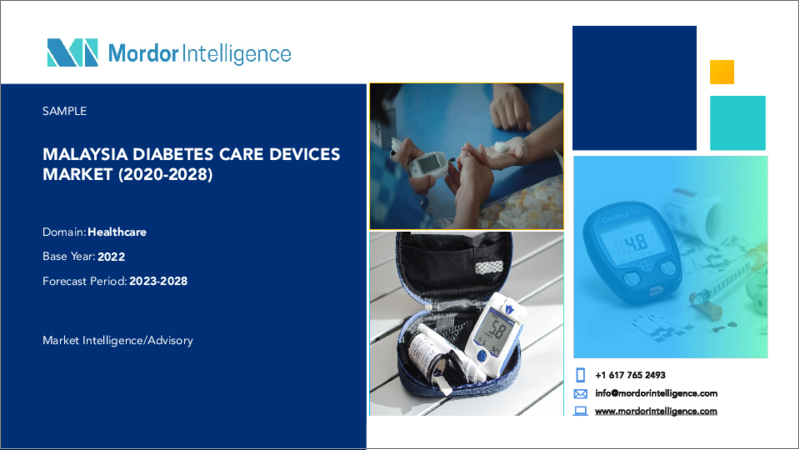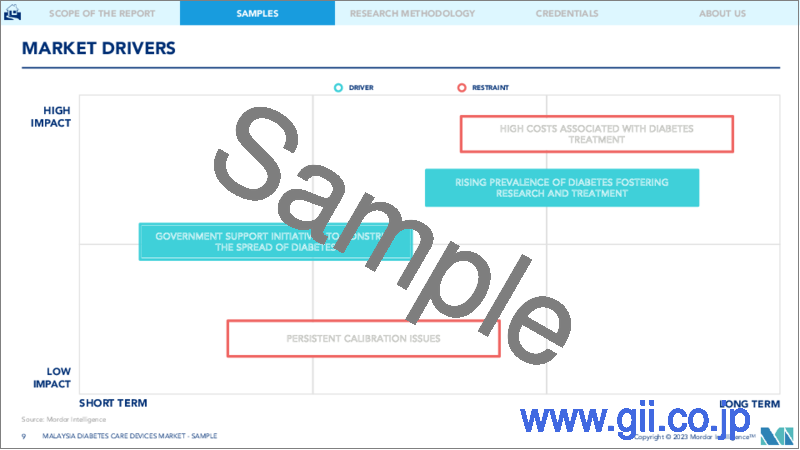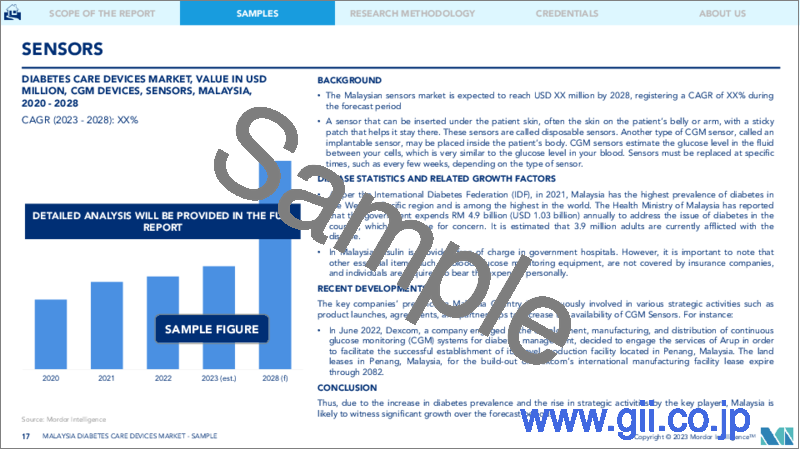|
|
市場調査レポート
商品コード
1146280
マレーシアの糖尿病治療デバイス市場- 成長、動向、予測(2022年~2027年)Malaysia Diabetes Care Devices Market - Growth, Trends, and Forecasts (2022 - 2027) |
||||||
|
● お客様のご希望に応じて、既存データの加工や未掲載情報(例:国別セグメント)の追加などの対応が可能です。 詳細はお問い合わせください。 |
|||||||
| マレーシアの糖尿病治療デバイス市場- 成長、動向、予測(2022年~2027年) |
|
出版日: 2022年10月31日
発行: Mordor Intelligence
ページ情報: 英文 70 Pages
納期: 2~3営業日
|
- 全表示
- 概要
- 目次
マレーシアの糖尿病治療デバイス市場は、予測期間である2022年から2027年にかけて、5.1%を超えるCAGRで推移すると予想されています。
マレーシア保健省は、東南アジアの国家が24時間以内に新たに5,809人のCOVID-19感染者を記録し、そのうち5,782人が国内感染、27人が輸入感染で、全国集計は2,541,147人となったと発表しました。これまでのところ、マレーシア国民の約78.4%がCOVID-19に対するワクチンを少なくとも1回接種しており、75.9%が完全に接種しています。今年マレーシアでCOVID-19で死亡した10人のうち、約4人が糖尿病だったと保健省はサンデー・スターに伝えています。マレーシアでは、5人に1人が糖尿病を患っており、18歳以上の約390万人が糖尿病です。
若い糖尿病患者は増加傾向にあります。より多くの若い人々が糖尿病になっており、18歳から40歳の患者数は過去15年間で倍増しています。糖尿病患者の増加は、心臓病、脳卒中、失明、慢性腎臓病、下肢切断など、この病気とその合併症の負担が増えることを意味しています。
実際、マレーシアにおけるコロナウイルスによる死亡者のほとんどは、糖尿病や高血圧などの基礎疾患を抱えており、その数は上位を占めています。
主な市場動向
マレーシアの糖尿病治療デバイス市場では、管理用機器が高い市場シェアを占める
マレーシアの糖尿病罹患率は西太平洋地域で最も高く、世界でもトップクラスであり、年間約6億米ドルの医療費がかかっています。この増加傾向は、人口増加、人口の高齢化、都市化、肥満や運動不足の割合の上昇など、いくつかの要因によるものです。本研究は、マレーシアにおける糖尿病および糖尿病予備群の有病率を体系的に把握し、その特徴を明らかにし、推計することを目的としています。欧米ではインスリンポンプの使用が、特に1型糖尿病患者の間で飛躍的に増加しているが、マレーシアでの使用はまだ非常に限られています。基礎インスリン注射は、中・長時間作用型のインスリン皮下注射に代わるもので、あらかじめ設定された速度で一日中継続的にインスリンを供給し、個人の特定の要件に基づいて変更されます。
アストラゼネカがマレーシア内分泌代謝学会(MEMS)と提携して支援するコミュニティイニシアチブである本初回調査は、複数の薬局およびメディアパートナーの支援を受けて、2021年4月12日から5月9日までオンラインで実施されました。この初回調査の目的は、マレーシアの意識レベルの基準値を得ること、また主要な知識のギャップを特定することです。今年の2,539の回答から得られた知見は、アストラゼネカとMEMSが今後1年間、一般向けの教育活動をどのように構想していくかを決定するものです。
予測期間中に市場を牽引する政府による取り組み。
マレーシアにおける糖尿病人口の増加
マレーシアでは糖尿病および糖尿病予備軍が増加しているため、マレーシア政府は国全体で糖尿病予防・管理プログラムを実施しています。マレーシア政府は、同国における糖尿病の有病率を下げるため、糖尿病に関する知識、コントロール、予防、治療を向上させる包括的なアプローチと計画を確立する必要があります。最近のNHMSによると、マレーシアの成人の2人に1人が体重過多または肥満であることがわかりました。糖尿病の人は、血液中のグルコースや糖分の濃度が高くなります。糖尿病は、血糖値をコントロールするためのインスリンというホルモンが体内で十分に分泌されないために起こる病気です。また、体がインスリンを効率的に使用しない場合にも起こり、インスリン抵抗性とも呼ばれます。このプロセスを促進する要因としては、肥満、不健康な食習慣、座りっぱなしのライフスタイル、遺伝などが挙げられます。マレーシアでは、同省の全国糖尿病登録(NDR)の統計によると、糖尿病患者の84%が太り過ぎであり、その中でも18歳から40歳までの若いマレーシア人が多いことが分かっています。同省は現在、「サマサマプログラム」と呼ばれる取り組みを検討しています。これは、糖尿病患者の家族や介護者がサポートを提供し、糖尿病のコントロールと予後を改善することを目的としたものです。「このプログラムでは、同省は民間セクターと協力して、ヘルスケアプロバイダーや介護者のトレーニングを行っています。同省は現在、サマサマプログラムを調査しています。このプログラムは、糖尿病患者の家族や介護者に力を与え、病気のコントロールと予後を改善するためのサポートを提供することを目的としています。このプログラムでは、医療従事者、ひいては介護者を育成するために、同省は民間企業と協力しています。
その結果、マレーシアの糖尿病治療デバイス市場は今後数年間で徐々に拡大すると予測されています。
競合情勢
持続的グルコースモニタリングのような糖尿病治療デバイスの新技術が、モニタリング機器の市場を拡大させました。DexcomによるTypeZero Technologiesの買収のようなプレーヤー間のM&Aは、インスリン自動投与への道を開いています。この買収により、Dexcomは単に持続的グルコースモニタリング機器市場を後押しするだけでなく、人工膵臓システムの開発競争において一歩リードすることになっています。
その他の特典
- エクセル形式の市場予測(ME)シート
- アナリストによる3ヶ月間のサポート
目次
第1章 イントロダクション
- 調査の前提条件と市場の定義
- 調査対象範囲
第2章 調査手法
第3章 エグゼクティブサマリー
第4章 市場の力学
- 市場概要
- 市場促進要因
- 市場抑制要因
- 産業の魅力- ポーターのファイブフォース分析
- 新規参入業者の脅威
- 買い手/消費者の交渉力
- 供給企業の交渉力
- 代替品の脅威
- 競争企業間の敵対関係
第5章 市場セグメンテーション
- モニタリングデバイス
- 自己血糖値モニタリングデバイス(金額および数量、2016年~2027年)
- グルコメーターデバイス
- テストストリップ
- ランセット
- 持続的血糖値モニタリング(金額および数量、2016年~2027年)
- センサー
- 耐久財
- 自己血糖値モニタリングデバイス(金額および数量、2016年~2027年)
- 管理デバイス
- インスリンポンプ(金額および数量、2016年~2027年)
- インスリンポンプデバイス
- インスリンポンプリザーバー
- 輸液セット
- インスリン注射器(金額および数量、2016年-2027年)
- インスリンカートリッジ(金額および数量、2016年-2027年)
- 使い捨てペン(金額および数量、2016年-2027年)
- インスリンポンプ(金額および数量、2016年~2027年)
第6章 市場指標
- 1型糖尿病人口(2016年~2027年)
- 2型糖尿病人口(2016年~2027年)
第7章 競合情勢
- 企業プロファイル
- Becton and Dickenson
- Medtronic
- Insulet
- Tandem
- Ypsomed
- Novo Nordisk
- Sanofi
- Eli Lilly
- Abbottt
- Roche
- Lifescan(Johnson &Johnson)
- Dexcom
- 企業シェア分析
第8章 市場機会および将来動向
The Malaysia Diabetes Care Devices Market is expected to register a CAGR greater than 5.1% over the forecast period, 2022-2027.
The Malaysian Ministry of Health announced that the Southeast Asian nation recorded 5,809 new COVID-19 cases in 24 hours, including 5,782 domestically infected and 27 imported ones, bringing the national tally to 2,541,147. So far, about 78.4 percent of the Malaysian population have received at least one dose of vaccine against COVID-19, while 75.9 percent have been fully vaccinated. Out of every 10 people who died from COVID-19 in Malaysia this year, about four of them had diabetes, the Health Ministry tells Sunday Star. In Malaysia, one in five people lives with diabetes which works out to about 3.9 million people aged 18 and above.
Young diabetics are on the rise. A higher number of younger people are getting diabetes, with the number of patients aged between 18 and 40 doubling over the past 15 years. The rising number of diabetics means an increased burden of the disease and its complications: heart disease, stroke, blindness, chronic kidney disease, and lower limb amputation, among others.
In fact, most of the coronavirus deaths in Malaysia have underlying comorbidities, with diabetes and hypertension topping the list.
Key Market Trends
Management Devices Hold Highest Market Share in Malaysia Diabetes Care Devices Market
Malaysia has the highest rate of diabetes in the Western Pacific region and one of the highest in the world and costing around 600 million US dollars per year. The rising trend is due to several factors, including population growth, population aging, urbanization, and rising obesity and physical inactivity rates. The rising incidence of diabetes and its consequences in Malaysia inspired this study to systematically identify, characterize, and estimate the pooled prevalence of diabetes and prediabetes in Malaysia. Although the use of insulin pumps in the West has increased by leaps and bounds, especially among type 1 diabetic individuals, its use in Malaysia remains very limited. The basal insulin infusion, which substitutes the intermediate- or long-acting subcutaneous insulin injection, provides insulin continuously throughout the day at pre-set rates that are changed based on the individual's specific requirements.
A community initiative supported by AstraZeneca in partnership with the Malaysian Endocrine & Metabolic Society (MEMS), The first-ever survey took place online from 12 April until 9 May 2021, with the support of several pharmacies and media partners. The purpose of this inaugural survey is to obtain a baseline of Malaysia's awareness level and also to identify key knowledge gaps. The insights from this year's 2,539 responses (which have been stratified to represent the overall population) will shape the way AstraZeneca and MEMS conceptualises public education initiatives in the year ahead.
The Goverenment intiatives driving the market in forecast period.
Increasing Diabetes Population in Malaysia
Because diabetes and prediabetes are on the rise in Malaysia, the Malaysian government implements diabetes prevention and control programs across the country. The Malaysian government should establish a comprehensive approach and plan to improve diabetes knowledge, control, prevention, and treatment to reduce the prevalence of diabetes in the country. Being overweight and obese are key drivers of the younger diabetes population in Malaysia. recent NHMS found that one in two adults in Malaysia is overweight or obese. Those with diabetes have high levels of glucose or sugar in their blood. It's a disease that is caused by the body not producing enough of the hormone insulin to control the amount of blood sugar. It can also be caused when the body doesn't use insulin efficiently, also known as insulin resistance. Factors that drive this process include obesity, unhealthy eating habits, sedentary lifestyles, and genetics. In Malaysia, current statistics from the ministry's National Diabetes Registry (NDR)show that 84% of patients with diabetes are overweight, and among them are young Malaysians aged 18 to 40. The ministry is currently looking into an initiative known as the Sama-Sama program, which aims to empower family members and caregivers to provide support for people living with diabetes to improve control and outcomes of the disease. "Under the program, the ministry is joining forces with the private sector to train healthcare providers and later, caregivers. The ministry is now investigating the Sama-Sama program, which aims to empower family members and caregivers to offer support for persons living with diabetes to enhance disease control and outcomes. The ministry is collaborating with the commercial sector on the program to train healthcare personnel and, subsequently, carers.
As a result, the diabetes care devices market in Malaysia is predicted to expand gradually in the coming years.
Competitive Landscape
The new technologies in diabetes devices, like continuous glucose monitoring, increased the market for monitoring devices. The mergers and acquisitions between the players, like the acquisition of TypeZero Technologies by Dexcom, are paving the way for automated insulin delivery. The acquisition has sent Dexcom ahead on its way in the race to create an artificial pancreas system, rather than merely offering a boost to the continuous glucose monitoring devices market.
Additional Benefits:
- The market estimate (ME) sheet in Excel format
- 3 months of analyst support
TABLE OF CONTENTS
1 INTRODUCTION
- 1.1 Study Assumptions and Market Definition
- 1.2 Scope of the Study
2 RESEARCH METHODOLOGY
3 EXECUTIVE SUMMARY
4 MARKET DYNAMICS
- 4.1 Market Overview
- 4.2 Market Drivers
- 4.3 Market Restraints
- 4.4 Industry Attractiveness - Porter's Five Force Analysis
- 4.4.1 Threat of New Entrants
- 4.4.2 Bargaining Power of Buyers/Consumers
- 4.4.3 Bargaining Power of Suppliers
- 4.4.4 Threat of Substitute Products
- 4.4.5 Intensity of Competitive Rivalry
5 MARKET SEGMENTATION
- 5.1 Monitoring Devices
- 5.1.1 Self-monitoring Blood Glucose Devices (Value and Volume, 2016 - 2027)
- 5.1.1.1 Glucometer Devices
- 5.1.1.2 Test Strips
- 5.1.1.3 Lancets
- 5.1.2 Continuous Blood Glucose Monitoring (Value and Volume, 2016 - 2027)
- 5.1.2.1 Sensors
- 5.1.2.2 Durables
- 5.1.1 Self-monitoring Blood Glucose Devices (Value and Volume, 2016 - 2027)
- 5.2 Management Devices
- 5.2.1 Insulin Pump (Value and Volume, 2016 - 2027)
- 5.2.1.1 Insulin Pump Device
- 5.2.1.2 Insulin Pump Reservoir
- 5.2.1.3 Infusion Set
- 5.2.2 Insulin Syringes (Value and Volume, 2016 - 2027)
- 5.2.3 Insulin Cartridges (Value and Volume, 2016 - 2027)
- 5.2.4 Disposable Pens (Value and Volume, 2016 - 2027)
- 5.2.1 Insulin Pump (Value and Volume, 2016 - 2027)
6 MARKET INDICATORS
- 6.1 Type-1 Diabetes population (2016-2027)
- 6.2 Type-2 Diabetes population (2016-2027)
7 COMPETITIVE LANDSCAPE
- 7.1 Company Profiles
- 7.1.1 Becton and Dickenson
- 7.1.2 Medtronic
- 7.1.3 Insulet
- 7.1.4 Tandem
- 7.1.5 Ypsomed
- 7.1.6 Novo Nordisk
- 7.1.7 Sanofi
- 7.1.8 Eli Lilly
- 7.1.9 Abbottt
- 7.1.10 Roche
- 7.1.11 Lifescan (Johnson &Johnson)
- 7.1.12 Dexcom
- 7.2 Company Share Analysis




